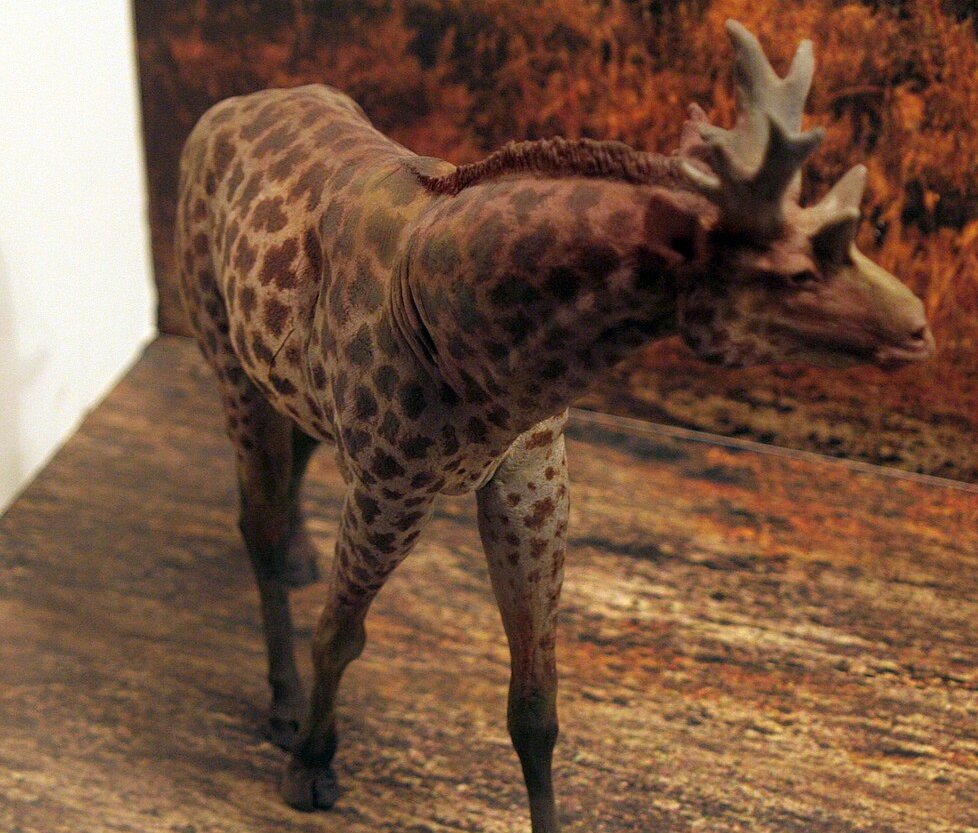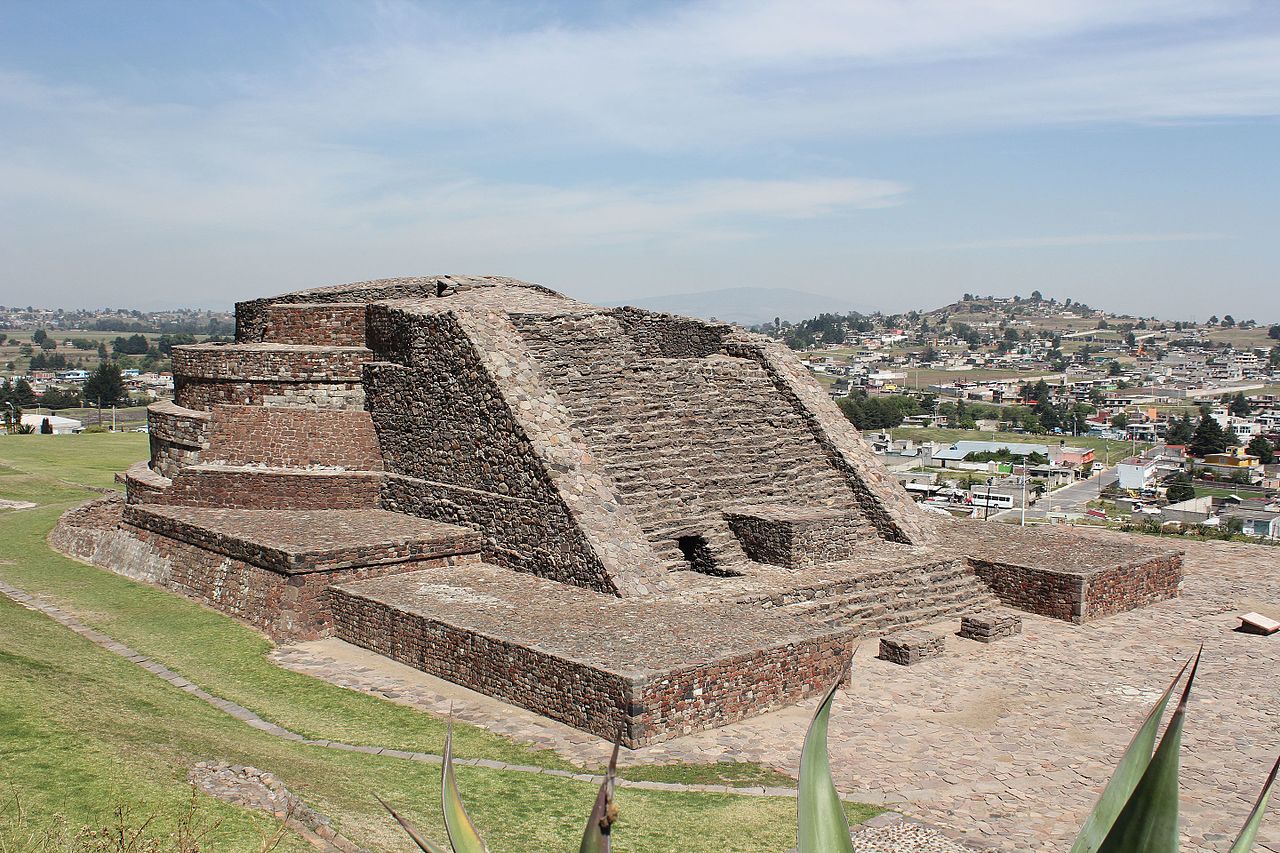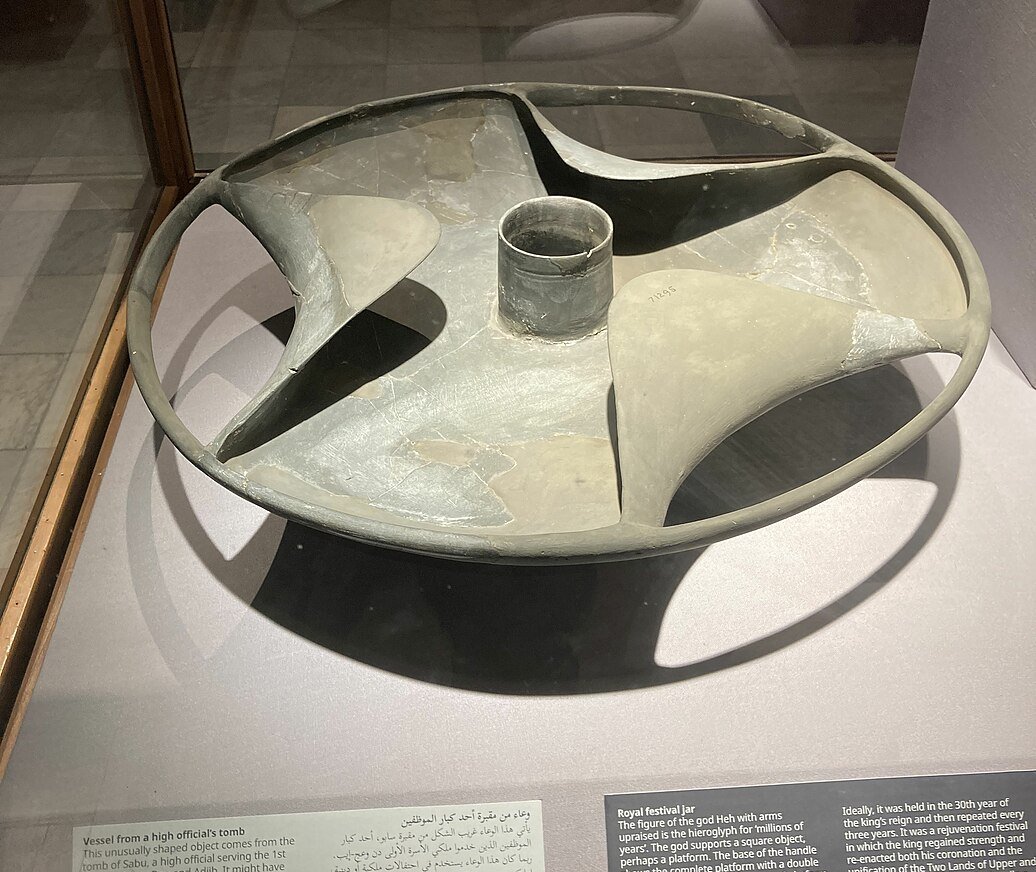Where Did They Come From?
Out-of-place artifacts are artifacts found in unusual contexts, without a logical explanation for why they're there. Often, they are objects seemingly too advanced to be found in certain locations. Here are some out-of-place artifacts, some solved and some still mysteries.

The Antikythera Mechanism
Found in a shipwreck and believed to have been developed by the Ancient Greeks, the antikythera mechanism is a hand-powered orrery, or model of the Solar System. It is the oldest known example of an analog computer and was used to predict astronomical positions and eclipses decades in advance.
Based on what we know about the Ancient World, this is far more advanced than we would have assumed the culture was.
 Marsyasm, CC BY-SA 3.0, Wikimedia Commons
Marsyasm, CC BY-SA 3.0, Wikimedia Commons
The Maine Penny
The Maine penny, also known as the Goddard coin, is a Norwegian silver coin dated to the reign of Olaf Kyrre, King of Norway (1067–1093 CE). It was claimed to be discovered in the US state of Maine in 1957. As a result, some argue it's evidence of pre-Columbian contact between the southern parts of North America and Europe.
However, although it is accepted that Vikings did briefly establish colonies in what is now Newfoundland and Labrador in the 10th century, there is no evidence of Viking migration further south.
 Stenersen, L. B, Wikimedia Commons
Stenersen, L. B, Wikimedia Commons
The Tamil Bell
The Tamil Bell is a piece of a bronze bell inscribed with Tamil script, found in 1836 in New Zealand by missionary William Colenso. It was being used as a pot by Māori women. This is where it gets weird. There was no known trade between Māori and Asia prior to European contact, so there is no explanation of how it reached New Zealand.
 John Turnbull Thomson, Wikimedia Commons
John Turnbull Thomson, Wikimedia Commons
Coins From Marchinbar Island
In 1944, nine coins were discovered on Marchinbar Island in the Northern Territory of Australia. While four of the coins were from 18th century Netherlands, the other five were from the Kilwa Sultanate on the Swahili coast in east Africa.
Some historians believe this is evidence of African contact with Aboriginals in Australia before European contact and colonization.
 Khalidsalewa, CC BY-SA 4.0, Wikimedia Commons
Khalidsalewa, CC BY-SA 4.0, Wikimedia Commons
The Shroud Of Turin
The Shroud of Turin contains what resembles a sepia photographic negative. But through radiocarbon dating, the image seems to have been produced between the years 1260 and 1390.
Some Christians have traditionally believed that the Shroud Of Turin is a “photograph” of Jesus, but this dating means it is no older than 1260 CE. That's not the mystery, though. There is no known method for creating the image "negative" image which has been conclusively identified.
The Baghdad Battery
The Baghdad Battery is the name given to a set of three artifacts that researchers fond found together: a ceramic pot, a tube of copper, and a rod of iron. Some fringe theorists have hypothesized that it may have been used as a galvanic cell for helping create electricity. Likely, however, it was in reality a system for storing scrolls.
The Dorchester Pot
The Dorchester Pot was a metal vase-like object that was recovered in two pieces after an explosion used to break up rock at Meeting House Hill, in Dorchester, Massachusetts in 1851.
To some theorists who see it as an ancient artifact, it's evidence that conventional models of geology or the length of the human presence on Earth are wrong. The truth? Historians and archeologists have identified it as a Victorian-era candlestick, or else a pipe holder.
 K. Bharatha Iyer, Wikimedia Commons
K. Bharatha Iyer, Wikimedia Commons
Kingoodie Artifact
The Kingoodie artifact was reportedly a corroded nail people apparently found encased in solid rock. The stone itself was quarried from the Kingoodie quarry in Scotland, and the artifact’s discovery was officially reported to the British Association for the Advancement of Science in 1845.
What it was and how it got there is a still a mystery, and there are no photographs of it.
 Dr Duncan Pepper, Wikimedia Commons
Dr Duncan Pepper, Wikimedia Commons

History's most fascinating stories and darkest secrets, delivered to your inbox daily.
Lake Winnipesaukee Mystery Stone
The Lake Winnipesaukee mystery stone is a dark, egg-shaped artifact found in a town near Lake Winnipesaukee in New Hampshire that bears several carved symbols, including a face. In 1872, workers found it while digging a hole for a fence post.
Originally thought to be a record of a treaty between tribes, subsequent analysis has called its authenticity into question. The stone's age, purpose, and origin remain unknown.
 John Phelan, CC BY-SA 3.0, Wikimedia Commons
John Phelan, CC BY-SA 3.0, Wikimedia Commons
Sivatherium Of Kish
The Sivatherium of Kish is an ornamental war chariot figurine discovered in the Sumerian ruins of Kish, in what is now central Iraq, in 1928. The figurine includes a quadrupedal mammal—with branched horns, a nose ring, and a rope tied to the ring—that resembles a Sivatherium.
This is notable because a Sivatherium is a relative of the giraffe that lived in North Africa and India during the Pleistocene, but was believed to have become extinct early in the Holocene extinction event, long before the dating of the chariot.
 Shalom, CC BY-SA 3, Wikimedia Commons
Shalom, CC BY-SA 3, Wikimedia Commons
The Tecaxic-Calixtlahuaca Head
Researchers fond an offering head made from terracotta between three fully intact floors of a Mexican burial site dating between 1476 and 1510. The head is of Roman appearance and there are claims it is far older than the burial site.
If so, some believe this is evidence of Roman trade in the New World or Viking expeditions farther south than previously thought.
 Arian Zwegers, CC BY 2.0, Wikimedia Commons
Arian Zwegers, CC BY 2.0, Wikimedia Commons
The Westford Knight
A glacial boulder in Westford, Massachusetts contains a pattern that appears to be a human-made carving. There are claims that it is evidence of pre-Columbian contact with Medieval Europe in the New World.
 Daderot, CC0, Wikimedia Commons
Daderot, CC0, Wikimedia Commons
Abydos Helicopter
The Abydos helicopter is part of an Egyptian hieroglyph carving from the Temple of Seti I at Abydos. Its palimpsest relief has two overlapping inscriptions; the title of Ramesses II is superimposed on those of his predecessor Seti I.
Ancient astronaut believers suggest that the hieroglyph was a depiction of a helicopter, evidence of advanced or extraterrestrial technology in Ancient Egypt.
 Olaf Tausch, CC BY 3.0, Wikimedia Commons
Olaf Tausch, CC BY 3.0, Wikimedia Commons
Dendera Lamps
The Dendera Lamps, or more commonly, the Dendera light, is a motif in the Hathor temple at Dendera in Egypt. According to the hieroglyphic text surrounding the pieces, it depicts statues referencing part of the Egyptian creation myth. Believers in out-of-place artifacts, however, suggest it depicts electric light bulbs.
 Olaf Tausch, CC BY 3.0, Wikimedia Commons
Olaf Tausch, CC BY 3.0, Wikimedia Commons
Sabu Disk
The Sabu disk is an ancient Egyptian artifact from the First Dynasty, circa 3000 to 2800 BCE. The function and meaning of the carefully crafted natural stone vessel are unclear, but the disk is notable for the almost machine-like precision of its lines.
 Martin1833, CC0, Wikimedia Commons
Martin1833, CC0, Wikimedia Commons
The Iron Man
The Iron Man (or Eiserner Mann) is an old iron pillar buried partly in the ground in Central Europe and is alleged by some to be an out-of-place artifact. A metallurgical investigation in the 1970s, however, showed that the pillar is made of pig iron and is consistent with medieval methods of ironworking.
 Chris Walters, Wikimedia Commons
Chris Walters, Wikimedia Commons
Iron Pillar Of Delhi
The Iron Pillar of Delhi is a pillar that appears to be rust-proof. As such, it supposedly demonstrates more advanced metallurgy than was available in India before 1000 CE.
London Hammer
In 1936 in London, Texas, a local couple found a 19th century hammer made of iron and wood, somehow partially encased in minerals that were millions of years old.
Although the hammer has its believers, the most likely explanation is that, some time in the 19th century, travertine limestone deposits encased and then quickly hardened around the hammer.
 S. J. Miba, CC BY-SA 4.0, Wikimedia Commons
S. J. Miba, CC BY-SA 4.0, Wikimedia Commons
Meister Footprint
The Meister Footprint is a slate record of two trilobytes that appear to have been crushed by a human foot, even though it dates from the Cambrian period long before humans existed.
Although cited by creationists as an out-of-place artifact, paleontologists identified it as the result of spall formation, a geological process.
 Peter Halasz, Wikimedia Commons
Peter Halasz, Wikimedia Commons
Pacal's Sarcophagus Lid
The carved stone sarcophagus lid of Mayan rule Pacal the Great in the Temple of Inscriptions is a unique piece of Classic Maya art, but it took on an entirely different meaning in the 1960s.
The tomb appeared in Erich von Däniken's 1968 best-seller Chariots of the Gods?, a book whose hypothesis suggests that the technologies and religions of many ancient civilizations were given to them by ancient astronauts. In the book, von Däniken compares the sarcophagus lid to the cockpit of the Mercury space capsule of the 1960s, and asserts that the sarcophagus lid was in fact a spaceship’s cockpit.
 Madman2001, CC BY-SA 1.0, Wikimedia Commons
Madman2001, CC BY-SA 1.0, Wikimedia Commons
Piri Reis Map
The Piri Reis map is a world map compiled in 1513 by the Ottoman admiral and cartographer Piri Reis, and is remarkable for being the earliest depiction of Antarctica—long before Antarctica had apparently been discovered. Nonetheless, many did believe Antarctica existed before they laid eyes on it.
Quimbaya Airplanes
Quimbaya "airplanes" are golden objects found in Colombia and made by the Quimbaya civilization. Their resemblance to airplanes has led to suggestions that they depict ancient flying machines. The Gold Museum in Bogotá describes them as figures of birds and insects.
 Santandergrl, Wikimedia Commons
Santandergrl, Wikimedia Commons
Saqqara Bird
The Saqqara Bird is a model bird made of sycamore wood and mounted on a stick. It was discovered during the 1898 excavation of the tomb of Pa-di-Imen in Saqqara, Egypt and dated to approximately 200 BCE.
Its purpose is unknown and it is not capable of flight. However, some theories suggest that it is in fact a depiction of a glider, and is a model of a full-sized glider Ancient Egyptians would have used for human flight.
 Dawoud Khalil Messiha, Wikimedia Commons
Dawoud Khalil Messiha, Wikimedia Commons
Shakōkidogū
Shakōkidogū are small humanoid and animal figurines made during the late Jōmon period (14,000–400 BCE) of prehistoric Japan. For all that they are ancient, they are said to resemble contemporary ideas of extraterrestrial astronauts.
 Rc 13, CC BY-SA 4.0, Wikimedia Commons
Rc 13, CC BY-SA 4.0, Wikimedia Commons
Stone Spheres Of Costa Rica
The stone spheres of Costa Rica are generally but incorrectly described as perfectly spherical. As such, it is suggested that they demonstrate greater stone-working skills in pre-Columbian times than has previously been known. Myths surrounding the stones suggest that they came from the lost city of Atlantis.
 Axxis10, CC BY-SA 3.0, Wikimedia Commons
Axxis10, CC BY-SA 3.0, Wikimedia Commons
Bosnian Pyramid Complex
The Bosnian pyramid claims concern the cluster of natural hills in the area of Visoko in central Bosnia and Herzegovina. Semir Osmanagić, a Bosnian American businessman, claims they are the largest human-made ancient pyramids on Earth, built by ancient Bosnians.
 TheBIHLover, CC BY-SA 4.0, Wikimedia Commons
TheBIHLover, CC BY-SA 4.0, Wikimedia Commons
Fuente Magna
Fuente Magna is a large stone vessel that was discovered in Bolivia in 1950. It contains engravings on its inside that have been compared to the earliest Sumerian cuneiform writing. Archeologists have described the patterns as “gibberish” and believe that it is probably a fake or a locally-made oddity.
 none, CC BY-SA 4.0, Wikimedia Commons
none, CC BY-SA 4.0, Wikimedia Commons
Gunung Padang Pyramid
Gunung Padang is an archaeological site in West Java, Indonesia. Located at 2,904 ft above sea level, the site covers an extinct volcano in a series of five terraces bordered by retaining walls of stone that are accessed by 370 successive steps.
While it has been misidentified as a 20,000-year-old pyramid, the Sundanese people consider the site sacred.
 RaiyaniM, CC BY-SA 4.0, Wikimedia Commons
RaiyaniM, CC BY-SA 4.0, Wikimedia Commons
Klerksdorp Spheres
The Klerksdorp spheres are small objects, often spherical or disc-shaped, found in South Africa and dating from millions of years ago. Geologists who have studied these objects have concluded that the objects are not manufactured and are the result of natural processes. Nonetheless, some believe they could only have been manufactured by intelligent beings.
 Robert Huggett, Wikimedia Commons
Robert Huggett, Wikimedia Commons
The Aiud Object
The Aiud object is an aluminum wedge found in 1974 in the Mureș River in central Romania, near the town of Aiud. Ufologists claim that it is of ancient extraterrestrial origin. In all likelihood, it is a fragment of modern machinery that was lost during some excavation work.
 me, CC BY-SA 3.0, Wikimedia Commons
me, CC BY-SA 3.0, Wikimedia Commons
The Ararat Anomaly
The Ararat anomaly is a structure appearing in photographs of the snowfields near the summit of Mount Ararat, Turkey. Some Christian believers thought it was the remains of Noah's Ark. The true story?
It was first filmed during a US Air Force aerial reconnaissance mission in 1949 and was later identified as linear facades in the glacial ice rather than an ancient structure.
 Procher Taylor, Wikimedia Commons
Procher Taylor, Wikimedia Commons
Coso Artifact
In 1961, geode prospectors found what they believed to be an ancient spark plug encased in a geode. The artifact has since been identified as a 1920s-era Champion spark plug that became encased in a concretion, or mineral precipitation.
 Pierre Stromberg, CC BY-SA 4.0, Wikimedia Commons
Pierre Stromberg, CC BY-SA 4.0, Wikimedia Commons
Nampa Figurine
The Nampa figurine was a clay-fired doll found in Nampa, Idaho during a well drilling. It was initially dated as 2 million years old due to the rock layer it was found within. Later analysis dated it from as early as a few thousand years, but it is most likely a 19th century Native American doll.
 George Frederick Wright, Wikimedia Commons
George Frederick Wright, Wikimedia Commons
Babylonokia
The Babylonokia is a clay tablet that is shaped like a mobile phone. It was created as an artwork in 2012, but fringe scientists have deliberately misrepresented a photograph of the artwork as showing an 800-year-old archaeological find.
 Karl Weingärtner, CC BY-SA 4.0, Wikimedia Commons
Karl Weingärtner, CC BY-SA 4.0, Wikimedia Commons
Calaveras Skull
The Calaveras skull was a seemingly ancient human skull found by miners in Calaveras County, California. To some, the skull proved that humans, mastodons, and elephants had coexisted in prehistoric California. It was later revealed as a hoax.
 Saopaulo1, CC BY-SA 3.0, Wikimedia Commons
Saopaulo1, CC BY-SA 3.0, Wikimedia Commons
Cardiff Giant
In the 19th century, exhibitors showed off The Cardiff Giant, a ten-foot-tall petrified man supposedly from biblicl time. Even at the time, experts debunked it, and the creator of the hoax later confessed to the forgery. People of the day nonetheless continued to marvel at it.
 Martin Lewison, CC BY-SA 2.0, Wikimedia Commons
Martin Lewison, CC BY-SA 2.0, Wikimedia Commons
Crystal Skulls
Crystal skulls were found and displayed as evidence of advanced stone-cutting skills in pre-Columbian Mesoamerica. The skulls, however, were made in the 19th century and planted as a hoax.
Gosford Glyphs
The Gosford Glyphs are a collection of supposedly Egyptian hieroglyphs found in Central Coast, Australia in the 1970s and used as proof of pre-European contact between Ancient Egypt and Aboriginal Australians. Authorities have dismissed the hieroglyphs as a hoax.
 Zroota, CC BY-SA 4.0, Wikimedia Commons
Zroota, CC BY-SA 4.0, Wikimedia Commons
Illicit Substances In Egyptian Mummies
Traces of nicotine and an illicit white powder—both native to the Americas— were found in Egyptian mummies. One theory is that there was contact between Africa and the Americas prior to European contact and colonization, with New World plants being traded in Africa and making their way to Ancient Egypt.















